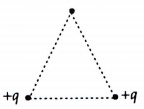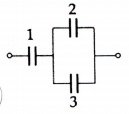Assignment:
Problems:
1) Three point charges are fastened at the corners of an equilateral triangle of side a as shown. The two charges at the bottom corners are +q each. Give answers in terms of k, q and a.
a. Let the charge at the top also be +q. It is released from rest while the others remain fixed.
i. Describe its motion.
ii. When it is far from the others, what is its kinetic energy? [What are the initial and final potential energies?]
b. Now let the charge at the top be -q, and again it is released from rest.
i. Describe its motion.
ii. What is its maximum kinetic energy? [At what point in the motion is the potential energy the smallest?]

2) A 1µF parallel plate capacitor is charged by a 100 V battery. The separation between the plates is slowly reduced until the capacitance becomes 2 μF , while the battery remains connected.
a. How much has the capacitor's stored energy increased?
b. How much additional charge AQ has been put on the plates?
c. How much additional energy was added to the system by the battery? [It moves charge ΔAQ through potential difference 100 V.]
d. Account for the difference between your answers to (a) and (c)
3) Consider a system of three identical parallel plate capacitors (numbered 1, 2, 3) each having a capacitance C =1 μF and connected as shown.
a. If 60 V is applied across the terminals of the system and the capacitors become fully charged, how much energy is stored in capacitor 1?
b. The system is now isolated from the charging source, and a slab of dielectric with x = 2 is slipped between the plates of 1, filling the gap completely. What is the new stored energy in 1? [What remains constant]?
c. What is the new potential difference across the terminal.
